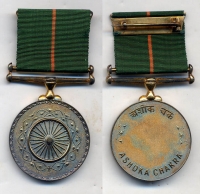Brave Hearts

Ashok Chakra Award
It is India’s highest peacetime military decoration awarded for valour, courageous action or self-sacrifice away from the battlefield. It is awarded for the “most conspicuous bravery or some daring or pre-eminent valour or self-sacrifice” other than in the face of the enemy. The decoration may be awarded either to military or civilian personnel. It replaced the British George Cross.
Origins
The medal was established on January 4, 1952 as the “Ashoka Chakra or Ashok Chakra, Class I” as the first step of a three-class sequence of non-combatant bravery decorations. In 1967, these decorations were removed from the “class-based” system and renamed as the Ashoka Chakra, Kirti Chakra, and Shaurya Chakra.
Until now 57 members have been awarded with Ashok Chakra Award. The first award winner was Naik Nar Bahadur Thapa in 1952. Prior to Independence, 17 Indians were awarded the British George Cross or its precursors. The George Cross and its precursors were equivalent to the Ashoka Chakra.
Eligibility
- Officers, men and women of all ranks of Army, Navy and Air Force, of any of the Reserve forces, of the Territorial Army, Militia and of any other lawfully constituted forces.
- Members of the nursing services of the armed forces.
- Civilians from all walks of life and members of police forces including
Central para-military forces and railway protection force.
Award Winners
Ashok Chakra
Lance Naik Mohan Nath Goswami (Posthumous), 9 PARA (Special Force)
Kirti Chakra
Subedar Mahendra Singh, Sena Medal, 9 PARA (Special Force)
Sepoy Jagdish Chand (Posthumous), 546 DSC Platoon
Shaurya Chakra
- Colonel Santosh Yashwant Mahadik (Posthumous), Sena Medal, 41 Rashtriya Rifle (PARA)
- Major Praphul Kumar Bhardwaj, 12 PARA (Special Force)
- Major Anurag Kumar, 9 PARA (Special Force)
- Major Sandip Yadav, 55 Rashtriya Rifle (Armed)
- Lieutenant Harjinder Singh, 3 KUMAON
- Naik Satish Kumar (Posthumous), 21 Rashtriya Rifle (Guards)
- Naik Kheem Singh Mehra, 21 KUMAON
- Sepoy Dharma Ram (Posthumous), 1 Rashtriya Rifle (MAHAR)
Youngest Recipient
Neerja Bhanot, flight purser for Pan Am, became the youngest recipient of India’s highest peacetime award for bravery, the Ashok Chakra in 1987. She was shot dead while saving hundreds of passengers on board a US-bound Pan Am plane which terrorists had hijacked it to Karachi airport on September 5, 1986.

Karunakara M Reddy
Videos
Videos
Videos
@ignitingmindsmagazine
@IgnitingMindsin
Top Stories
- Dedicated to the Sparrows, Forests and Water
- The United Nations Decade of Ecosystem Restoration
- How technology in agribusiness affects climate change, a concrete solution.
- Restless Youth Seek Climate Action
- Telangana Jagruthi International Youth Leadership Conference 18,19,20th January 2019
- Sports for Climate Action Framework launched at COP24
- COP24: One Week of Misgivings
Videos
Businesses
- Can Home Remedies Increase Your Height.
- Success Comes When We Make Innovation a Habit
- Do You Want to Be a Green Entrepreneur?
- Igniting Minds Official Web Portal Launched in New Delhi.
- Strive To Drive The Life
- Do Mobile Apps Facilitate Small Businessmen?
- Water Conservation, Preservation and Restoration. A Global Engineering Challenge.